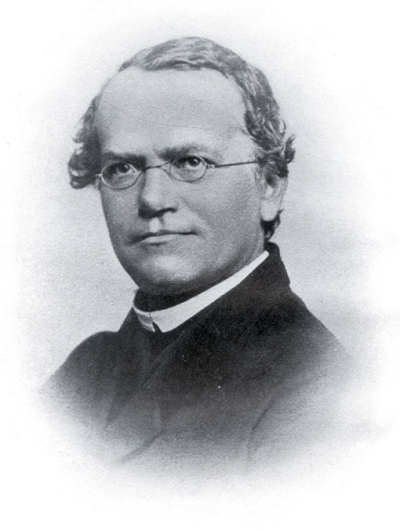MENU
The Electronic Scholarly Publishing Project: Providing world-wide, free access to classic scientific papers and other scholarly materials, since 1993.
More About: ESP | OUR CONTENT | THIS WEBSITE | WHAT'S NEW | WHAT'S HOT
ESP Essays 14 Dec 2025 Updated:
Mendel's Work, I
Approach and Methodology
Like begets like, more or less. Although this basic fact of heredity has been known since ancient times, the actual mechanisms of heredity, indeed, even the mathematical patterns of heredity, were completely unknown until Gregor Mendel did his breakthough work. When he published his findings in 1866, the scientific world failed to recognize their significance and the work was largely ignored, until it was rediscovered in 1900. Then, many recognized the huge potential in his findings, triggering an explosion of work that, in just two decades, laid the complete foundation of our modern understanding of genetics.
Mendel's Approach

Gregor Mendel
By the mid-nineteenth century the fact of inheritance was well established. Animal and plant breeders had known for thousands of years that the attributes of the parent were important in determining the attributes of the offspring and they had routinely used that knowledge to increase the quality of their stocks. However, for all those years the mechanism of inheritance was not at all understood. One of the mistakes made by many early researchers was that they would often perform only one cross and then only examine the results from just one generation. Or, if they did follow the crosses for more than one generation, they almost never recorded the data separately for the different generations. In addition, these early workers almost never counted the numbers of different types of progeny that were produced.
In 1856 an Austrian monk, Gregor Mendel, began a study of heredity which employed several new techniques. When it was completed and published in 1865, it proved to be astonishingly accurate — with almost no substantial changes Mendel's ideas now constitute the foundations of the modern theory of genetics.
To see why Mendel was so successful when his predecessors failed, we must consider Mendel's approach to his research and the conceptual skills that he used in the analysis of his results. We will examine Mendel's work in some detail, because it provides an introduction to the study of genetics and to the experimental method. All of our modern knowledge of heredity rests upon the foundation of experimental science, and without an appreciation for the logic of scientific discovery there can be no real understanding of any scientific discipline.
An Aside on the Method of Science
Although there are many systems of belief that claim to offer explanations for the functioning of the physical universe, only one of these — science — contains within itself the rules by which its own most cherished and widely held beliefs are to be rejected. Science requires that each of its claims and statements be constantly subjected to test through experimentation — through a physical comparison of its predictions with actual reality. Beliefs that fail these tests are subject to doubt, and if legitimate explanations for their failure to meet the test cannot be found, they must be discarded.
For a statement to be a proper scientific claim, it must be testable through experimentation. Claims that because of their structure could never be rejected through testing do not qualify as scientific statements. Notice that this restriction in no way implies that all scientific claims are true or that all nonscientific claims are false or meaningless. It merely notes that the goal of science is the understanding of physical reality and it limits the province of science to assertions that can be tested against physical reality.
To appreciate how modern scientific reasoning differs from other patterns of thought, it is useful to outline its procedures. One such outline, expressed as a list of instructions is:
1.Ask clear and precise questions.
2.Gather unambiguous and reliable data to answer those questions.
3.Examine the data to detect patterns.
4.Interpret the patterns; that is, formulate one or more hypotheses to explain the patterns. (This step cannot be carried out mechanically — it requires ingenuity, creativity, insight, and, occasionally, inspired guesswork.)
5.Doubt the hypotheses and attempt to disprove them. This is accomplished by generating otherwise unlikely predictions from the hypotheses and then testing, through experimentation, to see if the predictions come true. (It is this step that makes science different from other patterns of thought.)
6.If a hypothesis fails its test (i.e., if the predictions do not come true), modify, expand, or reject and replace the hypothesis and then generate and test new predictions.
7.Repeat, repeat, repeat ...
Although this pattern may seem commonplace (after all, it is precisely this pattern of reasoning that is used to determine why a car won't start or why a toaster won't toast or ...), it deserves considerable thought. In examining Mendel's work one should note how his actual research relates to this idealized description and you should recognize how his explanations were suggested by his data and how they were subjected to testing and confirmation.
ESP Picks from Around the Web (updated 28 JUL 2024 )
Old Science

Weird Science

Treating Disease with Fecal Transplantation
Fossils of miniature humans (hobbits) discovered in Indonesia
Paleontology

Dinosaur tail, complete with feathers, found preserved in amber.
Astronomy

Mysterious fast radio burst (FRB) detected in the distant universe.
Big Data & Informatics

Big Data: Buzzword or Big Deal?
Hacking the genome: Identifying anonymized human subjects using publicly available data.